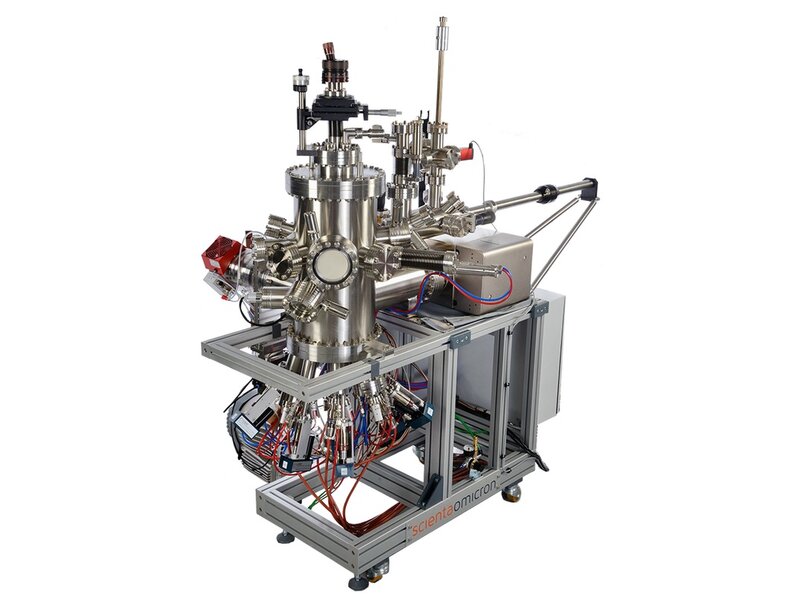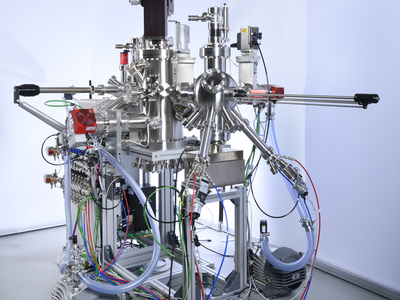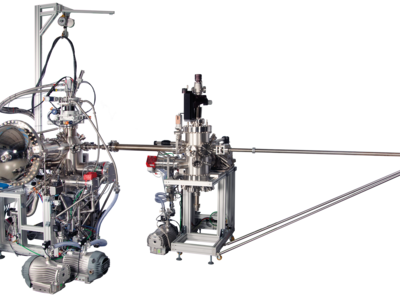Lab10 MBE System
Fundamental Research Tool for Epitaxial Layer Growth
- Research tool for innovative materials development
- Configurable and customisable
- Low cost of ownership
- Growth process controlled by advanced software
- Defined interface to Scienta Omicron analysis systems
- Deployed on the CREATE platform
The Lab10 MBE is a small sample deposition tool for explorative materials research under UHV conditions. It is a flexible system platform suitable for a large range of MBE applications such as the growth of 2D materials, intermetallic compounds, oxide heterostructures or organic layers. The Lab10 MBE includes superior evaporation control software and offers multiple ports for in-situ characterisation.
The system consists of a deposition chamber and an introduction chamber for sample exchange. The deposition chamber is equipped with an efficient cryopanel and an exchangeable cluster flange. It can be equipped with a wide range of high-quality effusion sources. Additional ports for in-situ growth control and view-ports are prepared. The Lab10 MBE employs the MISTRAL control system with touch screen and remote PC interface. Safety interlocks protect the UHV system in case of power failure.
Figure below: Dimensions of a Lab10 MBE in a stand-alone configuration. The compact dimensions of the Lab10 MBE system of 1800 x 920 x 1800 mm allow to integrate it in an existing laboratory or as an ideal module of a multi-technique cluster system. In standard configuration, the deposition chamber is pumped by an ion getter pump, a titanium sublimation pump and a turbomolecular pump, backed by an oil-free roughing pump.
The Lab10 MBE is fully compatible with the broad scope of Scienta Omicron analytic modules. Ultra-clean layer growth can be combined with advanced surface science techniques like SPM, AFM, XPS, HAXPES, ARPES and many others without breaking the vacuum. Materials Innovation Platforms (MIP) integrate instrumentation for growth and detailed characterisation of samples in-situ. Not only is sample quality preserved by maintaining UHV conditions, but analysis and growth can be done at intermediate process steps and performed far more rapidly than if the instrumentation was separated. Due to the compact footprint, the Lab10 MBE is an ideal module for a MIP, saving valuable lab space.
More Information
Deposition Chamber Concept
The deposition chamber of the Lab10 MBE is optimised for epitaxial growth of thin films on small sample sizes. Therefore, it is equipped with an efficient cryoshroud, to reduce the heat load around the manipulator and the water-cooled effusion cells. The large pumping ports allow high pumping speeds and are key for true ultra-high vacuum performance.
The exchangeable bottom cluster flange can be equipped with a wide range of high-quality effusion cells, cracker sources and electron beam evaporators. Additional ports for in-situ growth control and viewports are prepared.
Its proven chamber design with up to 8 effusion cells is revealed in an excellent thickness homogeneity for a 10x10 mm² substrate. The effusion cell capacity can range from 1 cm3 up to 35 cm3 for layer growth.
MISTRAL & Evaporation Control
The Lab10 MBE includes the MISTRAL control system together with a powerful evaporation control software. The control system is based on certified standard components for supreme reliability and provides a graphical status overview of all sensor values. Integrated safety interlocks protect the UHV system in case of power failure or a drop in water flow.
The evaporation control software offers a powerful script editor for programming individual process recipes. Additionally, 24/7 data logging of all relevant system parameters is included.
With this software bundle, experiments can be conducted under well-controlled and reproducible conditions.
Applications
The Lab10 MBE is designed for forefront research. It is a proven platform with more than thirty of such small-sample systems installed worldwide. Our customers use their systems for a variety of materials systems, such as:
- Topological Insulators
- 2D Materials, e.g. Transition metal dichalcogenides (TMDCs)
- Oxides
- Organics
- Intermetallic Compounds
- Semiconductors
- Heterostructures
- Thin Film Solar Cells
Specifications
Stainless steel
< 1×10-10 mbar
Ion gauge
Included
Programmable
Equipped with Viewport Shutters
Included
RHEED
Quartz Micro Balance
Beam Flux Monitor
Quadrupole mass analyser (RGA)
10 x 10 mm sample size
Temperature RT < T < 1400°C
(Temperature -110°C < T < 1000°C)
X/Y- travel ± 8 mm
Z- travel 50 mm
Azimuthal rotation ± 180°
Provision to work with direct sample heating
Including MISTRAL bias selector
3x DN63CF
4x DN40CF
1x central DN40CF
* Options for higher temperatures, LN2 cooling, oxygen resistance, and continuous rotation are available.
For full specifications and more information about product options, please do not hesitate to contact your local sales representative. Find the contact details here: Contact Us
Results
Interface-Induced Sign Reversal of the Anomalous Hall Effect in Magnetic Topological Insulator Heterostructures
The Berry phase picture provides important insights into the electronic properties of condensed matter systems. The intrinsic anomalous Hall (AH) effect can be understood as the consequence of non-zero Berry curvature in momentum...
Even–Odd Layer-Dependent Anomalous Hall Effect in Topological Magnet MnBi2Te4 Thin Films
Recently, MnBi2Te4 has been demonstrated to be an intrinsic magnetic topological insulator and the quantum anomalous Hall (QAH) effect was observed in exfoliated MnBi2Te4 flakes. Here, we used molecular beam epitaxy (MBE) to grow...
Interfacial Electron-Phonon Coupling and Quantum Confinement in Ultrathin Yb Films on Graphite
Interfacial electron-phonon coupling in ultrathin films has attracted much interest recently. Here, by combining angle-resolved photoemission spectroscopy and scanning tunneling microscopy, we report quantized electronic states and...
Reference Systems
Downloads

Lab10 MBE: Compact Solution for Epitaxial Layer Growth
The Lab10 MBE is a turnkey small sample research tool for innovative material development under UHV conditions. This system is designed to fulfill the highest and most stringent requirements of modern thin-film deposition. Furthermore, the small sample concept is intended to interface the MBE system with an UHV analysis module to offer the best platform for fundamental research of novel materials.

MBE Solutions: Modular MBE Systems
The MBE Solution is comprised of Lab10 MBE, EVO-25/-50 and PRO-75/100 enabling MBE and analysis in a single system. The key features include 1) excellent sample thickness and doping homogeneity; 2) layer growth with outstanding performance; 3) low background doping level; 4) excellent carrier density and mobility; and 5) very low defect density.












